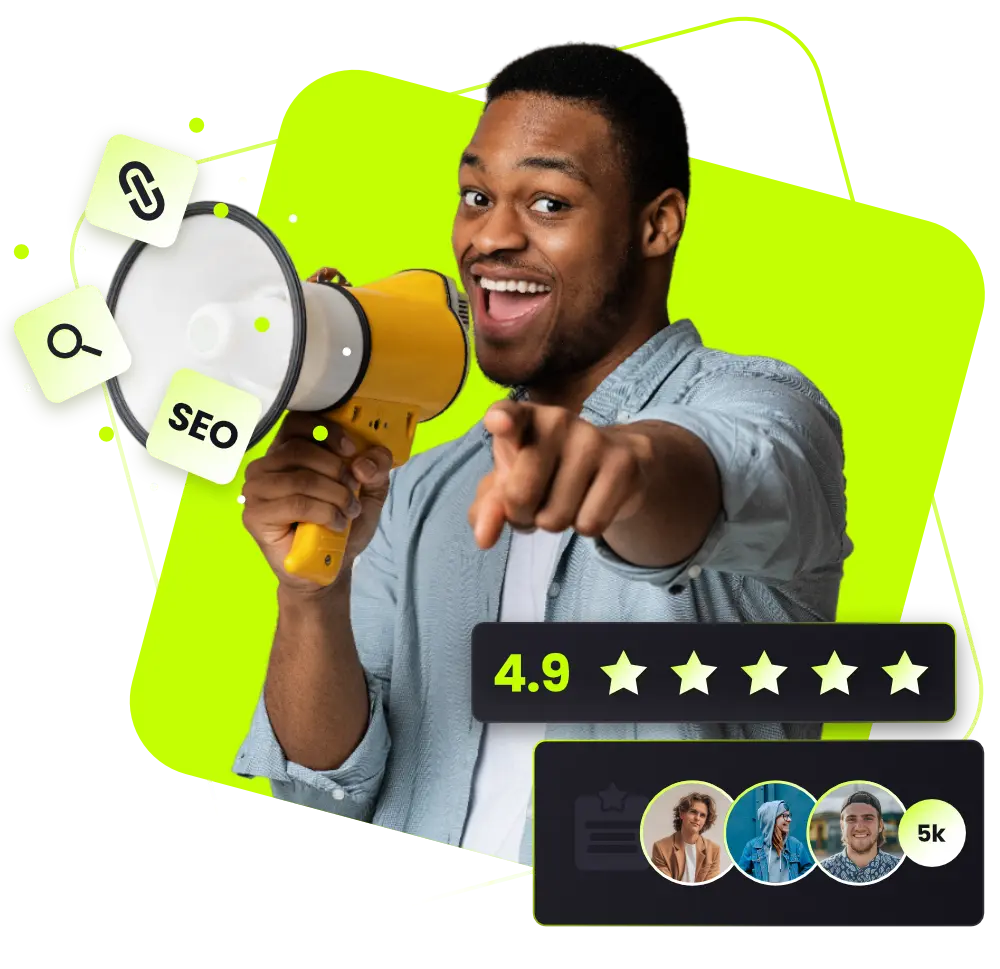Content Marketing and Link Building: The Recipe for Agency Growth
Daniel Trick
Jun 17, 2014
9 min read
Content and links are the two key ingredients for any successful SEO strategy.
Content provides a reason for people to visit a website, and links make a website easier to find in search results. Together, they increase your search visibility and clickability, helping you or your clients rise to the top.
In this guide, we’ll take a closer look at how these two work together and why it’s a good idea for agencies to offer both services.
You’ll also learn the step-by-step strategy we’ve used here at fatjoe to go viral and get tons of organic traffic.
We’ll cover:
- How content marketing and link building help each other
- Why you need to offer both services
- How to create a killer content and link building campaign
- The best types of content for link building
- How to perform outreach that gets responses
How Do Content Marketing and Link Building Help Each Other
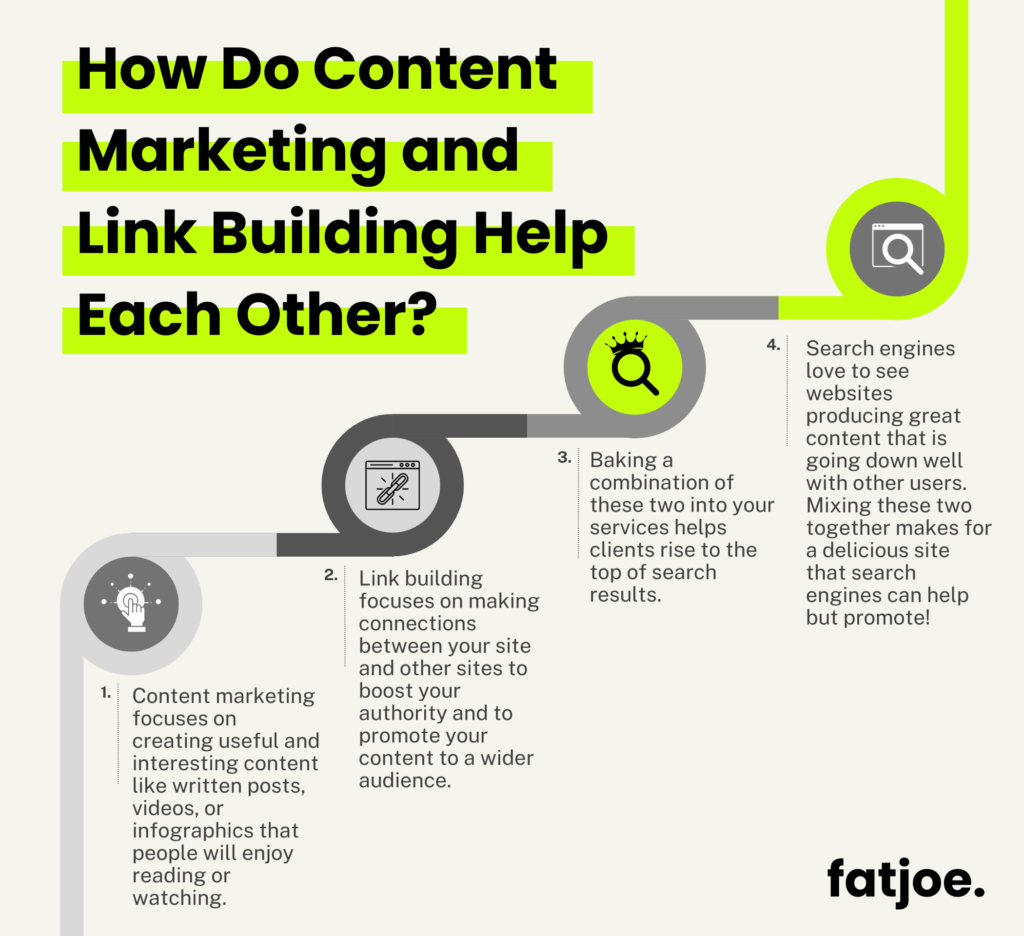
To understand how these two strategies support each other, we need to quickly recap the basics.
Content marketing is all about creating useful and interesting blogs, videos, and other content people enjoy reading or watching.
Link building is about making connections between your content and other websites to boost your authority.
Combining these two strategies allows you to reach more people and can significantly increase your online visibility.
Creating great content makes it easier to get links. People want to share and talk about things that are interesting or helpful.
And when you have high-quality links pointing to your content, the page is more likely to rank high in search engine results pages for your target keywords. That means more people can find and read your content.
With more people reading your content, it can attract even more links and get even more visibility. It’s a cycle of good things happening to your website.
After a 5 year hiatus, we started doing SEO again at the start of this year. Why didn’t you guys say it was still just content and links? pic.twitter.com/rUyREZtmsK
— Kurt Philip @ Convertica (@ConverticaOu) July 28, 2023
Why Should Agencies Offer Both Content And Links?
Content marketing gives people a reason to visit a website. You can create content throughout each stage of the buyer’s journey to attract and convert more potential customers.
But here’s the harsh truth: the “build it and they will come” mentality just doesn’t exist in the real world. And in most cases, it is just a long and painful route to failure.
You need links.
Backlinks are one of the most influential Google ranking factors. The more relevant, authoritative links you have, the more Google will see your content as valuable and deserving of a high ranking.
Search engines still rely on links to figure out which websites are trustworthy. And that’s unlikely to change any time soon.
Google:
“If other prominent sites on the subject link to the page, that’s a good sign that the information is of high quality.”
Lesson?
Don’t sleep on building LINKS.
— Jay hustler SEO (@jayhustlerSEO) April 20, 2023
As an agency, your job is to help businesses get found online and achieve their goals.
The best way to do that is with content and links.
That’s why it’s a good idea for agencies to offer both services.
It helps keep your SEO creative and unique, to stand out from the masses of competitors you’ll face.
It’s particularly useful for SEO and marketing agencies who need to show their clients results and prove their worth. Content alone is simply not enough.
How Do You Bridge the Gap Between Content Marketing and Link Building?
A winning SEO strategy involves creating high-quality content that has the potential of naturally attracting links and giving it some traction by building links manually.
Here’s the step-by-step process we’ve used to do just that:
Step 1 – Creating the Content
First, you need to create content that bloggers and website owners will want to link to. It could be an infographic, blog post, resource, or video.
Make sure it’s related to your industry and not just created as link bait. That’ll ensure you benefit from brand awareness and referral traffic for months and years to come – not just the links.
For our campaign, we created the infographic ‘Stats to Convince Your Boss To Invest in Content Marketing.’ We gathered the basic stats available in the public domain and put them together in a more interesting graphical concept with a clear target audience in mind.
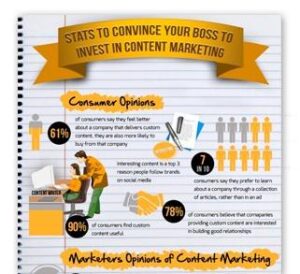
Struggling to come up with infographic ideas?
We just apply a simple approach to coming up with blog post titles and then ask ourselves, ‘Could this subject include bitesize statistics that would be attractive and easy to understand?’
If you need some help, check out our guide on creating clickbait blog post titles in 60 seconds or less.
Step 2 – Building Links
Once you have some awesome content to share, it’s time to build some links to make sure it gets the attention it deserves.
Building links manually in the short term can help your content gain traction.
There are a bunch of different ways you can go about this. Here’s a breakdown of the most popular link building techniques used by SEO pros:
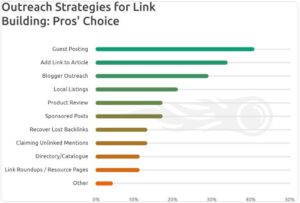
We’ve found that blogger outreach works best for this type of campaign.
Reach out to people you think would be likely to publish or reference your content. You can contact influencers who have shared similar content and look for websites and resources where similar content has been referenced.
For our campaign, we contacted bloggers to see if they were interested in publishing our infographic. Not only did we get some links, but many of these bloggers also shared the infographic on Twitter and Facebook.
We also submitted our content to infographic hosting sites like Visually and others.
It’s a bit of a laborious task but well worth it. Lots of these platforms mentioned and linked to our infographic on social media. And if you don’t have time to do this, we can do it for you.
Even if your campaign doesn’t go viral, you’ll still acquire a bunch of manual links that drive referral traffic and boost your search engine visibility. It also gives you something concrete to show your clients and prove your value.
And the Results…
To this day, we’re getting tweets, mentions, links, and referral website traffic. We also saw a huge improvement in organic visibility over a short period of time.
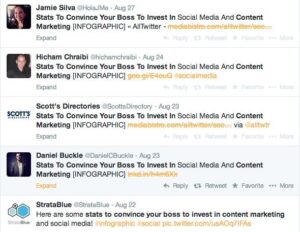
The trick to this successful campaign for us was to gain momentum quickly. It’s about making sure you do all the leg work (the link building and the infographic submissions) in a very short space of time.
Also, the information and how well the infographic engages the audience plays a huge part. Stats and figures work best!
The more people you can get to link to, mention, and even tweet or share on social networks, the quicker your campaign will take off. That can result in long-term results like this piece continually gives us.
We’re still getting tweets, links, referral traffic, and mentions almost 12 months on, with minimal effort in the early days.
Which Types of Content Work Best For Link Building?
There’s no secret formula that will work every time.
However, certain types of content tend to generate the best results for link building content marketing campaigns.
Content marketing for link building is often a cornerstone of digital PR as it’ll help you package original research or insights into an easily shareable format.
Blog Posts
Blog posts that go deep into a topic are great for these campaigns.
People want to share and link to well-researched and helpful blog posts because they’re valuable resources.
We’re not talking about a shallow 500-word post. You need to cover the topic in depth.
A Buzzsumo study found that long-form content gets significantly more shares:
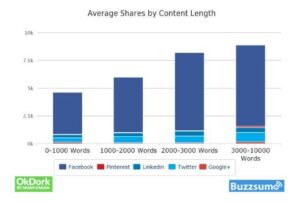
If your blog post solves a problem or fills an information gap, there’s a good chance people will want to share it on their websites and social channels.
Videos
Sometimes, a video can explain a topic faster and clearer than words alone.
A video is a great way to break down a complex concept, show people how to do something, or demonstrate how something works.
They are also a harder format to replicate. It’s much easier for bloggers and influencers to share your video in full than to summarize key points in their own posts.
That can mean more visibility and more links.
Infographics
Infographics use graphics and text to make information more engaging and easy to understand. People can quickly get the main idea without reading a lot of text.
This content type has worked well for our campaigns here at fatjoe.
Infographics are a great way to share interesting stats, facts, and data. That’s why they are one of the most trusted types of marketing content.
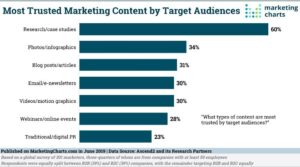
They are also easy to share on social media. The visual style is perfect for sharing on Twitter, Facebook, LinkedIn, and other platforms.
Original Research
Original research is one of the best ways to establish a business as a trusted source of information in its niche.
You gather new information or data and create a report, infographic, or video detailing your findings.
Because the information you provide is unique, you can get a ton of exposure and links.
A recent survey found data and research was the most popular link building method among advanced SEOs:
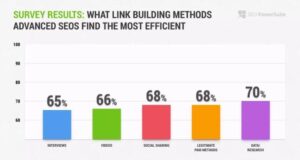
Even after some time, your research can still be valuable. When writers are looking to support their points, they might link to your research in their articles.
People will keep coming back to your information and linking to it for years to come.
This helps explain why content marketing links are so valuable to SEO as the links are self-sustaining and can continue to provide value years down the line.
How to Conduct Outreach for Link Building Campaigns
The success of your campaign depends on your outreach. Here’s how to do it:
Identify Potential Targets
First, you need to identify the people who can boost the reach of your campaign and are likely to be interested in sharing your content.
Tools like BuzzSumo are really useful for this task.
You can search for a relevant keyword, find related content, and see a list of individuals who shared the content on social media.
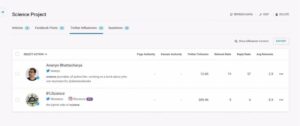
The goal is to identify individuals and websites that have previously shared or linked to content similar to yours.
Once you’ve identified potential targets, categorize them into groups like bloggers, journalists, and industry leaders.
This will allow you to tailor your approach based on each segment.
Craft Personalized Emails
Be as personalized as possible.
Start by briefly introducing yourself and explaining the purpose of your outreach. Then, emphasize how your content could add value to their audience or platform.
You can use a template for some of the details but always try to tailor your message based on what you know about the recipient.
The key to successful outreach is to always offer value. Highlight how your content can complement and add value to their existing content.
Use Outreach Tools
There are several tools you can use to help with your outreach efforts.
For example, Hunter is great for sourcing email addresses of potential targets.
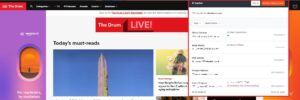
You can use tools like Semrush and Pitchbox to streamline the outreach process.
These tools enable you to send out personalized emails in bulk. They also make it super-easy to track responses and open rates.
You can measure the success rate of your outreach and adapt your approach based on what works best.
Outsource Content and Outreach to Focus On Client Strategy
There’s a lot that goes into a successful campaign.
That’s why many agencies choose to outsource the content creation and outreach process.
Your main job is to have a strategy that helps your clients achieve their goals. If you spend too much time on deliverables, you can end up neglecting the strategy.
Outsourcing gives you more room to think about and plan the best way to help your clients succeed.
1. Focus on the strategy 🔧
At an SEO agencies core should be a lean team of strategists that can orchestrate a winning long term strategies.
Once the strategy plan is in place, the deliverables just need to be fulfilled and the clients expectations managed.
— Joe Davies (@fatjoedavies) November 6, 2022
And outsourcing deliverables is super flexible. You can scale up at the start of the campaign and scale down when you get some traction and start generating natural links.
Get Better Results for Your Clients With Content AND Links
One of the biggest obstacles holding back SEO performance is the “build it, and they will come” mindset.
Creating high-quality content alone won’t help you get the brand awareness, traffic, and links you need.
However, if you build it and proactively get your content linked to, you will achieve much faster results. It’s a much more scalable content marketing strategy.
Even if the content campaign doesn’t generate the viral traction you think it deserves, you’ll have some links and placements to show your clients.
Become a Pro at SEO
Join 65,000 others and learn the secrets to SEO success with our weekly blog posts.
